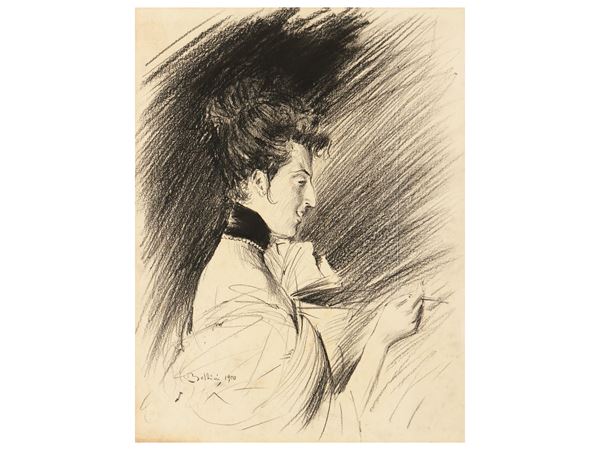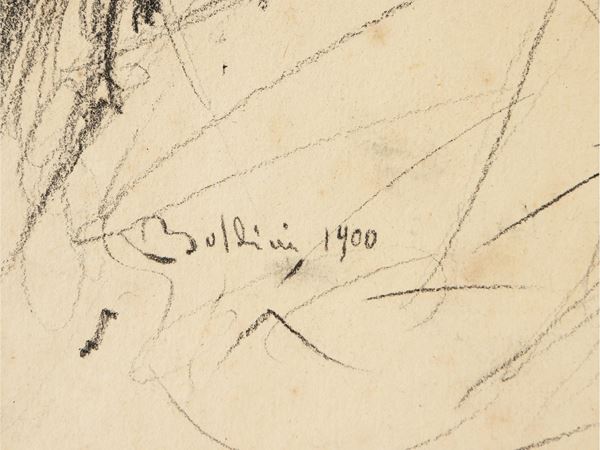Lot N. 133
Giovanni Boldini (1842 - 1931)
Duchess Nicoletta Grazioli, 1900
charcoal on paper, signed and dated lower left G. Boldini 1900
35x26.8 cm
Provenance: Private collectionNicoletta Maria Nazarena Gioacchina Margherita Giustiniani Bandini (Rome 1860–1938) had married Duke Mario Grazioli Lante della Rovere di Santa Croce di Magliano (1848-1936) on 20 February 1881, as attested by poetic compositions published for the occasion. The union, from which a son, Pio (1886-1954), was born, had painfully ended in divorce. An exponent of the Roman nobility, Nicoletta deserved a profile in the worldly chronicles of Emma Perodi which converged in 1895 in the volume Cento dame romane, where she was described as the embodiment of beauty itself, fascinating «when she walks lightly, with that gait of a goddess», « like when she listens to a conversation that she accompanies with a light smile and a long gaze from the beautiful Roman eyes: she never goes unnoticed, whether she walks along the Corso, as she usually does in the morning, or enters a living room. And as soon as she appears, all heads turn towards her, all eyes stare at her and faces assume that expression of bliss, which reveals the most enthusiastic admiration" (Emma Perodi, Cento dame romane. Profili, Bontempelli, Rome 1895, pp.79-80). To restore the appearance of this well-known and admired face is Giovanni Boldini who, around 1901, portrayed her, a mature woman full of vitality, in a small oil painting (in Bianca Doria, General catalog from the Boldini archives, Rizzoli, Milan 2000, card no. 424), which remains in the painter's studio. In the same period he also portrayed her in a pencil drawing (in Bianca Doria, The drawings of Giovanni Boldini. General catalogue, Skira, Milan 2011, nr. 2169) published by Robert de Montescquiou in the first issue of the Parisian newspaper "Les Modes" in illustration of an article on the women immortalized by the painter (Les peintres de la femme. Boldini, “Les Modes”, January 1901, pp.5-8). The famous writer stopped on that occasion to describe the «expressive face» of Duchess Grazioli, «with her adolescent brown hair, naturally curled, raised with an inimitable twist, and her beautiful head gracefully bristling with dark sparks of malice»; his attention was then attracted by «the velvet of a deep and intense black, a lithographic black of soot, [which] acts as a soft base for the thin profile», while «the invisible spiral of a cigarette emanates from a hand» very expressive, almost speaking."The mastery of Boldini as a designer described by Robert de Montescquiou is also found in our drawing, very close to the one published in 1901 and probably also created in 1900, considering the date of publication of the magazine. What they have in common is the composition of the sheet and the pose in which Countess Grazioli is portrayed and the rapid and confident use of the pencil, which here becomes harder and sharper in marking the profile and gaze. Here too, the face of Duchess Grazioli stands out against the black of the velvet collier de chien and against the background of darting diagonal lines, larger and more intense on the left, where the light comes from which hits the figure, making the naked back a focus of attention, as well as the thin and nervous hand holding the cigarette. Another known drawing portraying Nicoletta Grazioli dates back to 1907 (in Bianca Doria, I draw by Giovanni Boldini. General catalogue, Skira, Milan 2011, nr.2351) in which, under the signature and date, the painter had noted «made in pain."
€ 13.000,00 / 15.000,00
Estimate
Unsold






